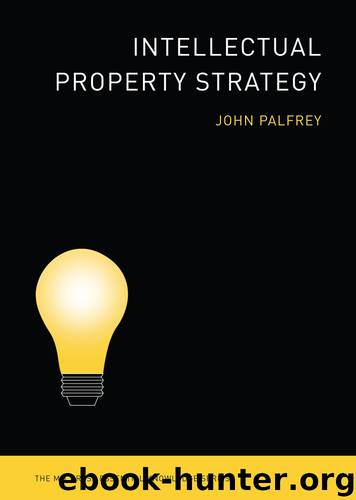Intellectual Property Strategy by John Palfrey

Author:John Palfrey [Palfrey, John]
Language: eng
Format: mobi, epub
Tags: Civil Law, Intellectual Property, General, Business & Economics, Law, Business Law
ISBN: 9780262516792
Publisher: MIT Press
Published: 2011-09-16T04:00:00+00:00
A Double Bottom Line for Intellectual Property: Strike a Profitable Balance, and Be Ready to Change
The hardest challenge that the CEO or senior manager faces in terms of intellectual property strategy is balancing the natural desire for control against the opportunities as well as challenges afforded by openness. These strategies are often in tension—a tension that may be impossible to resolve in full. But the creative use of a range of strategies in different circumstances can help an organization in myriad ways. These strategies can generate near-term profits for your organization while positioning you for a dynamic information-based global marketplace.
Organizations have traditionally created value primarily through innovations within the organization. Your employees innovate, you then build a market around what they have created, and finally you defend that market. Today, that’s still true to some extent. And it may well even serve as the cornerstone of your overall intellectual property strategy.
But it shouldn’t be the sum total of your approach. It is increasingly the case that many relevant innovations are made by others. The most familiar example is innovation by academic laboratories in the life sciences, which are licensed and exploited by private organizations. The open-source movement in the software field (think of the software that runs most servers, for instance, which is built on open-source technology) is another familiar story. As we’ve seen, much of the Web 2.0 environment online runs on a combination of open-source software and an interoperable series of Open APIs. Today, in some industries, the most interesting innovators are the organization’s competitors and customers. These are all instances where strategies that are not simply about full exclusion can reap huge benefits for organizations of all stripes.
The costs and benefits associated with intellectual property protection and litigation are growing over time, as organizations apply for far more patents each year in more markets and more industries. The quality of those patents, many critics argue, is low—and not getting better anytime soon. Likewise, entire industries are built online at the margins of the copyright law, where multibillion-dollar investments (think of Google’s acquisition for $1.4 billion of YouTube, the most prominent Web-based distributor of video content) bring potentially crippling liability with them. Organizations stand to gain tremendously from the innovations of their customers or members of relevant communities, as the open-source movement has shown, if the CEO can determine how to be open to listening to and incorporating these suggestions.
It is essential to focus on the big picture. Organizations in most industries connect together to form an ecosystem. As the intellectual property business grows in size and reach, the impact of the innovation of one organization increasingly affects what another organization may do. An organization’s competitors may innovate in ways that erect roadblocks to a CEO’s progress in important markets. Sometimes the threat comes from a third party seeking to profit from intellectual property development directly. A tide of innovation—where organizations are cooperating in some contexts rather than only competing—frequently can lead to higher returns for all market participants along with better choices, lower prices, and greater benefits for consumers.
Download
Intellectual Property Strategy by John Palfrey.epub
This site does not store any files on its server. We only index and link to content provided by other sites. Please contact the content providers to delete copyright contents if any and email us, we'll remove relevant links or contents immediately.
You Don't Own Me by Orly Lobel(1145)
Hello, My Name is Awesome by Alexandra Watkins(1084)
Intellectual Property Strategy by John Palfrey(1080)
Without Copyrights by Spoo Robert(977)
Democracy of Sound by Alex Sayf Cummings(961)
Profit From Your Idea: How to Make Smart Licensing Deals by Attorney Richard Stim(940)
World War 3.0 by Ken Auletta(903)
A Triumph of Genius: Edwin Land, Polaroid, and the Kodak Patent War by Ronald K. Fierstein(902)
The Trademark Guide by Lee Wilson(893)
Kafka's Last Trial by Benjamin Balint(845)
Data Protection: A Practical Guide to UK and EU Law by Carey Peter(838)
Patent It Yourself: Your Step-by-Step Guide to Filing at the U.S. Patent Office by Pressman David Attorney(822)
What They'll Never Tell You About the Music Business by Peter M. Thall(817)
Mass Media Law by Pember Don & Pember Don(811)
BVR's Guide to Intellectual Property Valuation by Michael Pellegrino(809)
Hello, My Name Is Awesome: How to Create Brand Names That Stick (BK Business) by Alexandra Watkins(809)
The Tech Contracts Handbook: Software Licenses and Technology Services Agreements for Lawyers and Businesspeople by David Tollen(793)
The Copywriter's Handbook by Robert W. Bly(784)
The New Censorship: Inside the Global Battle for Media Freedom by Joel Simon(768)
